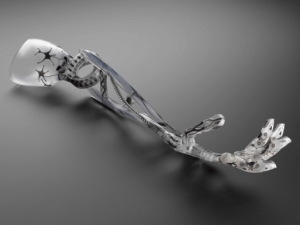In the future, will we be able to 3-D print replacement body parts? Researchers at the University of Nottingham are working hard to make such a future possible. To give the public a taste of what’s to come, Professor Richard Hague, director of the University’s Additive Manufacturing and 3-D Printing Research Group, and his students developed a mockup of a functional 3-D printed prosthetic arm for the 3d: Printing the Future exhibit at the Science Museum London. The arm, which is very Terminator-esque, will be on display among 600 3-D printed objects until July 1 of next year.
3-D Printing Both the Structure and the Moving Parts
Currently, 3-D printers are not sophisticated enough to build both the structure of an object and its electrical parts. “At the moment 3D printing uses single materials, a polymer or a metal, which are fused together with a laser,” said Hague. “You can create interwoven geometries but they’re still passive.” By combining structure, mobile joints and delicate sensors all in one process, however, the Terminator arm demonstrates how 3-D printers can create both structural and electrical parts for the same object, at the same time.
 By including circuits that sense temperature, feel objects and control the arm’s movement, Hague’s arm is an example of the breakthroughs to come in the near future of 3-D printing, some say even within the next 10 to 15 years. “3-D printing gives us the freedom to make complex, optimized shapes, and our research aim is focused on printing-in electrical, optical or even biological functions,” Hague said.
By including circuits that sense temperature, feel objects and control the arm’s movement, Hague’s arm is an example of the breakthroughs to come in the near future of 3-D printing, some say even within the next 10 to 15 years. “3-D printing gives us the freedom to make complex, optimized shapes, and our research aim is focused on printing-in electrical, optical or even biological functions,” Hague said.
Additive Manufacturing
In order to bring 3-D printing technology up to speed, Hague and his team are working to develop additive manufacturing technology that allows the machines to print whole systems rather than just individual parts of systems. Hague said:
What we’re looking to do is activate those and make them functionalize. So rather than make a component you make the whole system — an example might be rather than print a case for a mobile phone you make the whole phone — all the electronics, the case, the structural aspects, all in one print.”
Hague’s team also hopes to develop technology for jetting metal from 3-D printers as opposed to just flakes of metal in polymer ink.
The First of Its Kind
The Terminator arm is not the first 3-D printed prosthetic limb produced to date, but it is the most advanced. Previously South African carpenter Richard Van As created the open-source “robohand” project, focuses on creating 3-D printer designs for mechanical finger prosthetics. The ultimate goal of the robohand projet is too allow people who have lost fingers or who were born with missing or malformed digits to cheaply produce their own, customized prosthetics.
In the video below Hague speaks about the Terminator hand and the future of additive manufacturing and 3-D printing:
What do you think of 3-D printed prosthetic limbs? Will they change our future?
Image credits: The University of Nottingham



